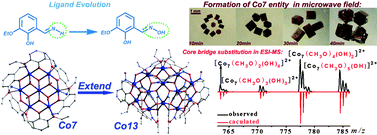Controlled assemblies of hepta- and trideca-CoII clusters by a rational derivation of salicylalde schiff bases: microwave-assisted synthesis, crystal structures, ESI-MS solution analysis and magnetic properties†
Abstract

* Corresponding authors
a Key Laboratory of Synthetic and Natural Functional Molecule Chemistry of the Ministry of Education, Northwest University, Xi'an, PR China
b
School of Chemistry & Chemical Engineering of GuangXi Normal University, Guilin, P. R. China
E-mail:
zmh@mailbox.gxnu.edu.cn

 Please wait while we load your content...
Something went wrong. Try again?
Please wait while we load your content...
Something went wrong. Try again?
L. Wei, B. Li, S. Hu and M. Zeng, CrystEngComm, 2011, 13, 510 DOI: 10.1039/C0CE00085J
To request permission to reproduce material from this article, please go to the Copyright Clearance Center request page.
If you are an author contributing to an RSC publication, you do not need to request permission provided correct acknowledgement is given.
If you are the author of this article, you do not need to request permission to reproduce figures and diagrams provided correct acknowledgement is given. If you want to reproduce the whole article in a third-party publication (excluding your thesis/dissertation for which permission is not required) please go to the Copyright Clearance Center request page.
Read more about how to correctly acknowledge RSC content.
 Fetching data from CrossRef.
Fetching data from CrossRef.
This may take some time to load.
Loading related content
